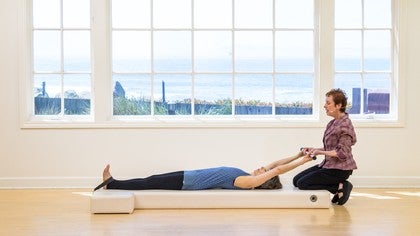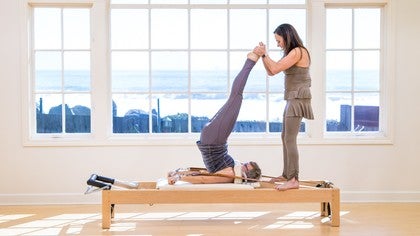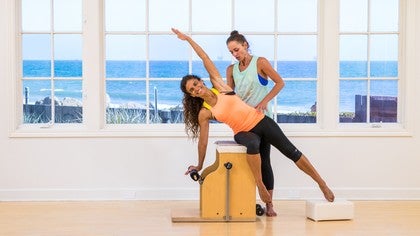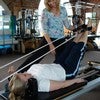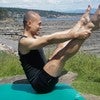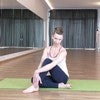Description
About This Video
Transcript
Read Full Transcript
Hi, I'm Debra Colet and I'm here with Ruth Alford and we're going to just do a short tutorial on the benefits of partnering to showing you a couple of examples of the PyLadies mat exercises. And while you, while Ruth is resting, I'll just say, uh, with regards to the partnering or really a modification of an exercise on any level, it's not so much that you're trying to make things easier for the person just for the sake of being easy, but your support, your hands on, your ability to help hold some of their weight is to help pick, pick them up out of their attention, pick them up out of the tight things that are actually making the exercise more difficult because the tension in the musculature acts as a, an added resistance, almost like you're trying to lift yourself up, but there's this pressure pushing you down in terms of something that's tight as you're, as you're trying to move. So the partnering that we're going to demonstrate today is really, it's not because she's unable, it's to actually help have a sense of, Oh, if I feel this partnering, I then am released from some of my habitual patterns and I can feel the potential of what it would like be like. And then I start to imprint those feelings in my own body and then I'm doing the exercises with a little bit more fullness. And then I get the benefit of the exercise more and then I end up creating my own partnership inside me instead of struggling. So hard to do it right. So we're gonna just start with the roll up, which is a very traditional exercise to partner.
And I'm going to give Ruth the poll. So one of the benefits of the pole is to actually add as an, as a partner to help. When you take your arms overhead, you don't want the weight of the pole to pull on you and tighten your back. What you're actually looking for is that the weight of the pole is lengthening you out all the way through your hips and through your spine. So my partnering for Ruth, I'm not just trying to yank on her arms to open her chest. I W and I certainly don't want to pull her shoulders out of the socket.
What I'm really looking for is to give her the sense that right off the bat she's got room through her shoulders, through her spine and through the front of her hips so that when, yes, exactly Ruth. When you flex your ankles like that, the relationship of the Dorsal flection, it's not just a shape, it's not just to keep the strap on, it's to actually help you open up into your hips so that your spine is going to be more free to rule. Okay, so this is the first part. I might say, take a breath and then exhale, and then we start together. Now maybe Ruth wouldn't necessarily want to do this exercise full out with her arms by her head, but with my help we can do, we can do it fully. So because I'm going to hold her. Okay. So she's going to pick her hat up, she's going to reach forward, and then I'm there and I can just keep coming. Not that she necessarily needs me, but I'm just gonna gently pull her forward. And then as she rolls back down, I'm holding, not only am I pulling her, I'm holding the weight of her up away from her hips so that she can more easily roll back down. And maybe I need to actually come back here because you know, maybe she doesn't realize how heavy that bar is. So I'll do it again. You know, when you partner somebody who wanted to let them go in the middle, you don't wanna drop them like a hot potato, right?
You have to feel into how much they're relying on you and know if, if you let go of them, do they realize how much you're helping them? Okay, so let's just do this one more time. So we're going to get you a little stretch. Take a nice inhale, suspend the chest, open the ribs, and then begin to come up. And then I'm just going to be there to help. To the degree that she needs me and she doesn't really need me all that much on this part. And now I'm going to pull you a little bit farther forward and you can crow more into yourself. Beautiful. Then we're gonna start to go back and again, I'm basically acting like a support for her flexors so that as she rolls down, if her back is tight, I'm helping her not have to rush through that part.
And then I could give her another stretch at the end and then you can just let go. Okay. That feels pretty good. Right? So go ahead and take one of your legs out of the strap and roll up to sitting. We're going to come into the spine stretch. That's it. So go ahead and place your feet apart. And so for this one, again, you're looking at some of the same issues, right? People's quads are tight, their lower back is tight. Sitting up like this with your legs out in front of you is not the most comfortable thing for a lot of people, as you know.
And of course we can modify by sitting up on something to let the legs release forward or modify by taking the legs off the mat altogether, having the legs lower than the pelvis, but we're showing some partnering. So what I'm gonna do for Ruth now is pick her up out of her hips again so that she can access the back of her legs better and the muscles around her pelvis to hold her up. So if I lift her, I am basically taking away the pole of her back muscles and her quads. And then as she goes over, she's freer. She's freer right off the bat and to the degree that she can keep rolling this action of the pelvis rolling over the femurs is freer. And then on the way up, I can just act as a bay, as a, as a guide for her spine.
Again, obviously Ruth doesn't really need me to do that, but it's nice you can kind of figure out where the end is. So I'll just do it again. I'm gonna hold her wrists. I'm somewhat short, so I usually bend my knees a little in and get into it. And you want to, if I was very tall, I'd be way up here. That would be awkward. But this is good and I'm just going to give her, I know what I want it to feel like she knows what she wants it to feel like I'm not doing something to her. I'm just affording her the sensation that she doesn't have to work so hard just to get the body to s to go where it wants to go.
And then I really want to make a point here that I'm not interested in pushing on her. I'm not trying to stretch her or push her beyond what her body wants to do. That's not it at all. Okay. Maybe it's nice if I give her a little stretch. Maybe I use my hand to kind of guide the idea of what the direction of the muscles are doing, what the direction of the movement is, where the direction of the movement is going, but I'm not pushing on her at all. Okay. And then again, I can put my leg, give her something to reach into.
And then from here, let's just go right into the saw. Okay. So you take your, I could start her here to right, instead of taking the arms out to the side, we could lift up one more time and then go ahead and start to rotate. And on this one, I guide the arm back and a little behind. Because what most of the people want to do is they're so determined to get that little finger to the little toe and that becomes what the whole thing is about. And then what you see is oftentimes again, people just reach and fall in their effort to get to their toe. And you're just re tightening in the front of the hip again and overstretching the back.
So instead what we're looking for is the line of direction of little total little finger to little toe. But we don't because we don't want to go down, because that's going to also just tend to make you go down, but you can go out at the same time. What we're looking at is the ability to sit back on the pelvis, feeling again, this power of the seat and continue to get the rotation along with the flection. So that's what my job is, is to keep her back here so that she's not falling and just hanging out on her hips and let's go to the other side. So then in between I would want to pick her up again. It feels kind of good, right? I could even pick her up and twister from here and then let the the down arm sweep back as the top arm sweeps forward.
Give a little bit of release to the skull. The other thing that I could do on this side, reus palace is very square, but I could take my foot and just nudge into the hip crease back a little bit to keep her, you know how most people when they do this or maybe you felt it, they fall in their effort to reach, but by putting my foot in there, I can just encourage that hip to stay back and get this turn. Now I'm not pulling her up this way to open her shoulder at all. We're allowing the shoulder girdle to roll forward and the lift of the tricep as you can see actually picks up the spine. And then if she can continue to curl back into herself, she's going to start to get a really yummy, yummy twist through the spine.
And again, don't push on your foot. Okay Ruth, you see how you're actually twisting your leg. That is going to disturb the tone up the outside of the leg coming into here, which is important as well so that you don't collapse down into your hip. Okay. Wanna do one more each side. Great. Okay, so big inhale up and twist and then exhale back. You go turning the shoulder on this side. I'll just use my foot. Can you let the shoulder rollover? There we go.
And then when I twist you with your ribs, I'm not pulling your shoulder open. That stays really getting it through the thorax. Good one more on your own. Big Inhale up, rotate over and exhale the back arms job. Yes. Is to pull you back and around that is phenomenal.
And it balances out the work of the front hand. Okay, great job. And then come up and relax. Okay, let's show, um, let's show an inverted exercise. Okay. So let's show the Jackknife. So you're gonna lie down again. What's the most difficult thing for a lot of people is managing the weight of their legs and pelvis, getting that up overhead and not letting that fall being able to control. So go ahead and bend your knees into your chest for this one and extend your legs. So my job is to give her the, the feeling, the understanding, the awareness that she can make again, space in her hips. You see?
So what I'm not going to do is pull her legs down. Should I show that? Can you handle it? Right? A lot of people just pull the legs down and you can see what's happening is all the weight is going into the back, into the spine. And so now she doesn't really have much choice but to bear weight down through her spine and in the neck and everything like that. So the hardest if you would to soften your knees just a little to have a little bit more power through the hips.
The hardest part is actually getting this initial lift up and then I'm going to take her over. Okay. Whether it's rollover or knife, but now we're here and my job is to hold the weight of her legs enough so that she feels confident in having her weight up onto her upper back. Encouraging you to breathe your chest up high and strong. And then as you come back and let's go ahead and take the feet a little bit higher. Okay? So then I'm here to hold them and then as you jack knife down, I don't let you pull your back down away from me holding your legs. I'm buying you time and control so that you lay that spine down without pulling your back down. Does that make sense? So we're going to roll you over again.
Lift and Jackknife. So what a lot of people do, and you might recognize this in yourself, I'm grabbing her heels, holding her legs. I have to use this hand now is they are up there and they roll down, they heard the Q roll your spine down, my pulling you to the side. And so they pull their back down. I don't even want you to do it. Instead what you're looking at as being able to keep the space in the front of your hip and lay the spine down with control through the front of the spine.
And one more time, lift the hips up, soften your knees just a little and then over you go. So my hand here at your sacrum, your palms pressing down to open the chest and then you're not going to put weight on my hand. So you have to use the strength of your legs in your hips to hold your pelvis app. So if you can't, then I would hold you. But let's just see what happens. Okay? Giving you this idea that I'm going to hold the weight of your pelvis so that it doesn't pull on your lower back.
Pull on your spine as you come down and then bend your knees and rest. Okay. There are so many exercises in the repertoire that we can support each other in finding that space that's needed. I would just say that with regard to that Jackknife, I know that we moved a little slowly. Jack Knife really has a little bit more dynamic dynamics to it, but I was just wanting to show what it takes to hold the weight and to buy the person time. In a way. I was always feel about partnering.
It's like you're buying somebody some time to when their way through their body mind synchronicity, so they're just not at the effect of the Poles in the tugs and then the more times one can experience something like that. Then as you was very simple, right? You either practice something and get better at doing it that way, or you practice it with this support and it's not, it's not just about getting better, but it's actually about being able to feel an alternative way. And then as your system gets more used to it, you reroute those pathways and then you're actually going to end up getting more benefit out of the exercise, which is r, which is what we want. Yeah. Thanks.
The Teacher's Corner: Hands-On Adjustments
Comments
Thank you Deborah for your depth of understanding and expressing it to us.
I am a DJ, too! (Debora Jean) I do, on occasion have the people in the class partner each other. I get a reading first. Usually I can tell from their faces if they are excited by the idea or wish I hadn't brought it up! Sometimes I hesitate to ask because I worry they will think it takes too much time to organize, but inevitably they enjoy it, get some laughs and helps people get to know each other
You need to be a subscriber to post a comment.
Please Log In or Create an Account to start your free trial.
